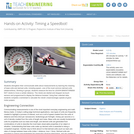
Size, Scales, and Specialization was developed as part of an effort by the Quantitative Biology at Community Colleges group to provide materials that incorporate mathematical concepts into biology courses. The activity uses published estimates of cell type numbers in the human body along with size, density and weight as a lens to have students calculate ratios, explore exponents, and better understand how the various cell types contribute to an average human's total weight and size. The activity is applicable for majors and non-majors biology courses, and maps to Chapter 4 of the OpenStax Biology 2e textbook. This activity could also be used in a mathematics course as a biologically relevant example.
The activity contains a pre-assessment to gauge student understanding of the material and provides an opportunity for students to predict the number of various cell types, as well as the mass of various cell types, in the human body. This prediction activity is followed with a guided approach to calculating these values. After guiding the students in this activity, students will then have a chance to practice the activity on a new set of cell data provided.
After completing this module students should be able to:
- Compare and contrast the structure and function of different cell types.
-- List the largest and the smallest cells in the body based on number.
-- List the largest and the smallest cells in the body based on mass.
- Describe the advantages of specialization in eukaryotic cells.
-- Give examples of how specialization in cell types affects cell size (volume) and shape.
- Perform measurements and conversions using the metric system.
-- Measure the scale of cell size variation in the human body
-- Calculate the relative proportions of cell types in the human body by mass and frequency
- Subject:
- Algebra
- Biology
- Life Science
- Mathematics
- Material Type:
- Activity/Lab
- Data Set
- Homework/Assignment
- Author:
- Heather Seitz
- Jillian Marie Miller
- Joseph Esquibel
- Date Added:
- 04/23/2021

